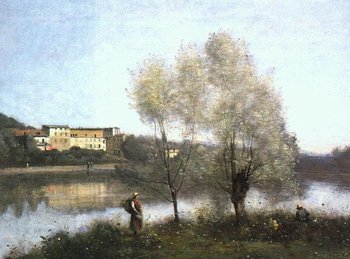Jean-Baptiste Camille Corot
|
|

Jean-Baptiste Camille Corot (July 26, 1796 – February 22, 1875) was a French landscape painter.
| Contents |
The art of Corot
Corot worked in the style of the realists and romantics of this time. Of the painters classed in the Barbizon school, Corot's art is more individual than Rousseau's, whose works are more strictly traditional; more poetic than that of Daubigny, who is, however, Corot's greatest contemporary rival; and in every sense more beautiful than Jean-François Millet, who thought more of stern truth than of aesthetic feeling.
Historians somewhat arbitrarily divided his work into periods, but the point of division is never certain, as he often completed a picture years after he began it. In his early period he painted traditionally and "tight" — with minute exactness, clear outlines, and with absolute definition of objects throughout. After his 50th year his methods changed to breadth of tone and an approach to poetic power, and about 20 years later, from about 1865 onwards, his manner of painting became full of mystery and poetry. In his final 10 years he became the "Père (Father) Corot" of Parisian artistic circles, where he was regarded with personal affection, and acknowledged as one of the five or six greatest landscape painters the world has seen, along with Hobbema, Claude, Turner and Constable.
Corot approached his landscapes more traditionally in than is usually believed. By comparing even his late period tree-painting and arrangements those of Claude, as that which hangs in the Bridgewater gallery, the similarity in methods is seen.
Besides landscapes, of which he painted several hundred, Corot produced a number of prized figure pictures. These were mostly studio pieces, executed probably with a view to keep his hand in with severe drawing, rather than with the intention of producing pictures. Yet many of them are fine compositions, and in all cases the colour is remarkable for its strength and purity. Corot also executed a few etchings and pencil sketches.
Biography
Camille_Corot_-_Woman_with_a_Pearl.jpg
Camille Corot was born in Paris, in a house on the Quai by the rue du Bac, now demolished. His family were bourgeois people, and unlike the experience of some of his artistic colleagues, throughout his life he never felt the want of money. After an education at Rouen, he apprenticed to a draper, but hated commercial life and despised what he called its "business tricks," yet he faithfully remained in it until he was 26, when his father consented to his adopting the profession of art.
Corot learned little from his masters. He visited Italy on three occasions, and two of his Roman studies hang in the Louvre. A regular contributor to the Salon, in 1846 the French government decorated him with the cross of the Legion of Honour, and he was promoted to an officer in 1867. His many friends considered, nevertheless, that he was officially neglected, and in 1874, a short time before his death, they presented him with a gold medal. He died in Paris and was buried at Père Lachaise.
A number of followers called themselves Corot's pupils. The best known are Boudin, Lepine, Chintreuil, Français and Le Roux.
During the last few years of his life he earned large sums with his pictures, which were in great demand. In 1871 he gave £2000 for the poor of Paris (where he remained during the siege), and his continued charity was long the subject of remark.
The works of Corot are scattered about France and the Netherlands, Britain and America.
Selected artwork
The following are among is best known work:
- Une Matinée (1850), now in the Louvre
- Macbeth (1859), in the Wallace Collection
- Le Lac (1861)
- L'Arbre brisé (1865)
- Pastorale — Souvenir d'Italie (1873), in the Glasgow Corporation Art Gallery
- Biblis (1875)
External links
- Corot biography and images at CGFA (http://cgfa.sunsite.dk/corot/index.html)
- The Webmusem on Corot (http://www.ibiblio.org/wm/paint/auth/corot/)
- Corot images at Artyst (http://www.artyst.net/C/Corot19/Corot.htm)
Template:Commonsde:Jean-Baptiste Camille Corot fr:Jean-Baptiste Camille Corot it:Jean-Baptiste Camille Corot nl:Camille Corot ja:カミーユ・コロー pt:Jean-Baptiste Camille Corot zh:讓-巴蒂斯·卡米耶·柯洛

